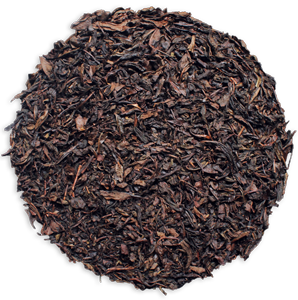El té oolong, también conocido como té azul, procede del árbol del té (Camellia sinensis), es una variedad de té chino que se encuentra entre el té negro y el té verde, siendo una de las variedades de té más valoradas en la actualidad.
Las hojas de este té han sido sometidas a un particular proceso de oxidación que les da su color negro azulado y que también aporta su característico aroma intenso, su sabor suave y afrutado.

PROPIEDADES Y BENEFICIOS
- Alto poder antioxidante, con beneficios claros para el sistema inmunológico. Tiene gran capacidad para proteger a las células y retrasar su envejecimiento.
- Propiedades anticancerígenas atribuidas a la alta presencia de catequinas en su composición.
- Protege al hígado, mejora las defensas y contribuye a quemar grasas.
- Poder estimulante, por su contenido en teína que, además, es reconocido por ser digestivo, astringente y diurético.
- Gran capacidad para luchar contra el estrés
- Excelente para acelerar el metabolismo y promover la pérdida de peso al reducir la cantidad de grasa que se absorbe en el sistema digestivo.
- Baja la presión sanguínea.
- Mejora la calidad del sueño gracias a los polifenoles, los cuales tienen un efecto tranquilizante.
- Mejora la flora intestinal.
- Reduce la inflamación vascular.
- Protege el cerebro y mejora la actividad cerebral, previniendo enfermedades como Alzheimer.
- Ayuda a prevenir la diabetes, gracias a los antioxidantes polifenólicos que reducen el azúcar en la sangre y nivela la insulina.
- Refuerza los huesos y los dientes.
- Alivia los síntomas de eczema en la piel gracias a sus antioxidantes polifenólicos.

COMPRA EN LÍNEA:
https://hierbasdemexico.com.mx/tienda/
Siempre es bueno estar informado al 100% y consultar con tu médico de confianza antes de tomar cualquier suplemento.
Producto 100% natural, su uso está destinado al consumo como alimento.
EL CONSUMO DE ESTE PRODUCTO ES RESPONSABILIDAD DE QUIEN LO RECOMIENDA Y DE QUIEN LO USA
REFERENCIAS
Wei C, Yang H, Wang S, Zhao J, Liu C, Gao L, Xia E, Lu Y, Tai Y, She G, Sun J, Cao H, Tong W, Gao Q, Li Y, Deng W, Jiang X, Wang W, Chen Q, Zhang S, Li H, Wu J, Wang P, Li P, Shi C, Zheng F, Jian J, Huang B, Shan D, Shi M, Fang C, Yue Y, Li F, Li D, Wei S, Han B, Jiang C, Yin Y, Xia T, Zhang Z, Bennetzen JL, Zhao S, Wan X.Proc Natl Acad Sci U S A. 2018 May 1;115(18):E4151-E4158. doi: 10.1073/pnas.1719622115. Epub 2018 Apr 20.PMID: 29678829 Free PMC article.
Here we present a high-quality sequence of the genome of tea, Camellia sinensis var. sinensis (CSS), using both Illumina and PacBio sequencing technologies. At least 64% of the 3.1-Gb genome assembly consists of repetitive sequences, and the rest yields 33,93 …
2) Safety Assessment of Camellia sinensis-Derived Ingredients As Used in Cosmetics.
Becker LC, Bergfeld WF, Belsito DV, Hill RA, Klaassen CD, Liebler DC, Marks JG Jr, Shank RC, Slaga TJ, Snyder PW, Gill LJ, Heldreth B.Int J Toxicol. 2019 Nov/Dec;38(3_suppl):48S-70S. doi: 10.1177/1091581819889914.PMID: 31840549 Review.
Cosmetic ingredients derived from Camellia sinensis (tea) plant parts function as antioxidants and skin conditioning agents-humectant and miscellaneous. …Because product formulations may contain multiple botanical ingredients, each containing the same constituents …
Bag S, Mondal A, Banik A.Microbiol Res. 2022 Jan;254:126890. doi: 10.1016/j.micres.2021.126890. Epub 2021 Oct 9.PMID: 34689100 Review.
Tea (Camellia sinensis) is perhaps the most popular and economic beverage in the globe due to its distinctive fragrance and flavour generated by the leaves of commercially farmed tea plants. …
Xie H, Feng X, Wang M, Wang Y, Kumar Awasthi M, Xu P.Bioengineered. 2020 Dec;11(1):1001-1015. doi: 10.1080/21655979.2020.1816788.PMID: 32881650 Free PMC article. Review.
We explore the recent studies regarding isolation approaches, distribution characteristics and diversity, and also biological functions of endophytic microbiota in Camellia sinensis (L.) O. Kuntze. Profoundly, the future insight into interaction mechanism between en …
Sun Y, Zhou J, Guo J.Front Biosci (Landmark Ed). 2021 Dec 30;26(12):1714-1722. doi: 10.52586/5063.PMID: 34994184 Free article. Review.
Abiotic stresses are wide-ranging environmental factors that adversely affect the yield and quality of tea plants (Camellia sinensis). As perennial woody economic plants, various environmental factors affect its growth and development. …



